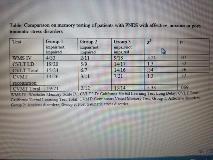Cognitive Impairments in Patients Diagnosed With Psychogenic Nonepileptic Seizures (PNES): What Role Do Psychiatric Comorbidities Play?
Abstract number :
3.374
Submission category :
11. Behavior/Neuropsychology/Language / 11A. Adult
Year :
2018
Submission ID :
501117
Source :
www.aesnet.org
Presentation date :
12/3/2018 1:55:12 PM
Published date :
Nov 5, 2018, 18:00 PM
Authors :
Lorna Myers, Northeast Regional Epilepsy Group; Ken Perrine, Weill Cornell Medicine; Robert Trobliger, Clinical Neuropsychology; Kirsty Bortnik, Northeast Regional Epilepsy Group; and Marcelo Lancman, Northeast Regional Epilepsy Group, Hackensack, NJ, USA
Rationale: PNES is a heterogeneous condition which presents with many different psychiatric conditions (affective, anxiety, post-traumatic stress, etc.). Each comorbidity may exhibit unique cognitive deficit subtypes.The purpose of this study was to determine if variability of memory functions (verbal and visual) in PNES occur in the context of mood, anxiety, and post-traumatic stress comorbidities. Methods: This is a retrospective study of 23 consecutive males (2007 to 2016) and 65 consecutive females (2014 to 2016) with video EEG-confirmed diagnosis of PNES. Patients were administered the California Verbal Learning Test-2 (CVLT-2), Continuous Visual Memory Test (CVMT), and Wechsler Memory Scale IV (WMS IV). Patients were divided into 3 mutually exclusive groups: Affective disorders (depression, bipolar), anxiety disorders (generalized anxiety, panic, social anxiety disorders), and post-traumatic stress (PTS). Eleven (8 females, 3 males) were excluded for failing a symptom validity test. Scores below a 2.5 standard deviation were classified as impaired. Chi square test was used to compare the 3 groups. Results: No statistically significant differences between groups were found on any sub-score. However, patients with post-traumatic stress exhibited a trend indicating worse performance on a test of narrative memory (WMS IV ?2=5.21, p= .07), while patients with anxiety exhibited a trend toward better performance on a test of visual memory (CVMT Total score ?2=5.33, p=.069). Conclusions: Although no significant differences were determined between groups; the post-traumatic stress group in the present sample exhibited a trend that replicates results from a previous report of narrative memory deficits in patients dually diagnosed with PNES and PTS. The anxious group also demonstrated an interesting trend of comparably better functioning on a visual memory test. Distinguishing the neuropsychology of PNES subgroups is important because it might allow us to identify remediable cognitive deficits that can be targeted through tailored treatments. In the future, larger samples of discrete psychiatric comorbidities would be useful in further clarifying the neuropsychology of PNES. Funding: None
